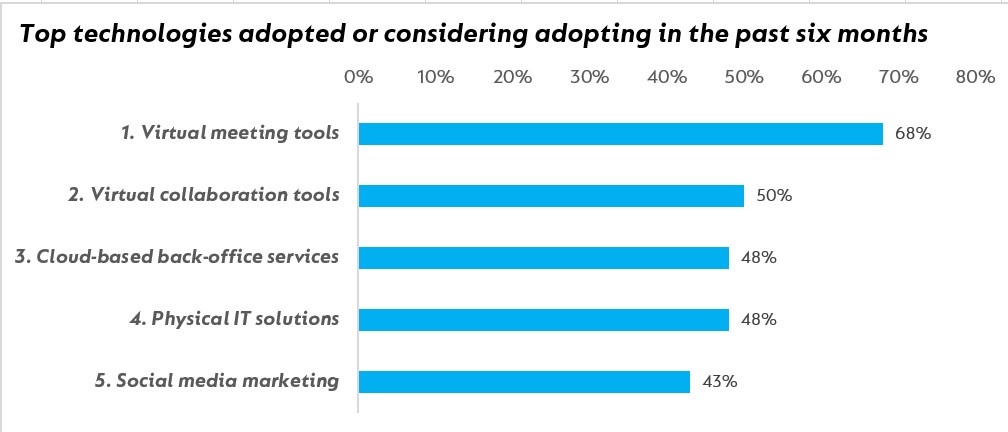After the toughest year in living memory for business leaders across the country, it’s been great to hear the news of successful vaccine trials. However, it may be some time before British businesses return to something that feels like normality. The latest productivity figures published by the Office for National Statistics (ONS) show that although there is a rise in how much each British worker produces since the start of the pandemic, it’s still below pre-crisis levels.
While it might have felt like a near impossible task over the last nine months, business leaders can improve the performance of their teams – and therefore overall productivity – during a pandemic. The prize is greater profits and a more resilient business.
The pandemic has been a huge trend accelerator – with perhaps the most seismic shift towards online, by both consumers and businesses. Business leaders have also been presented with new management challenges every day. The need for faster decision making and the extended period of remote working has forced many leaders to rapidly introduce new processes and new technology.
‘The first lockdown caused three years’ worth of innovation in the first three months of the pandemic’
The pace and scale at which business leaders have been able to respond, pivoting operating models and finding new revenue streams has been immense. Our research has found that the first lockdown caused three years’ worth of innovation in the first three months of the pandemic. Over half a million businesses made changes to the way they work.
Businesses of all sizes have been forced to adopt technology quickly. This goes beyond the “Zoom Boom” to include virtual collaboration tools and moving to the Cloud. As a result, two fifths of firms report that staff have become more comfortable with technology.
 The top technologies businesses have adopted or considered adopting (May – October 2020)
The top technologies businesses have adopted or considered adopting (May – October 2020)
As we look ahead to 2021, and news of potential vaccines gathers pace, business leaders need to start thinking about how they can make sure their business is in the strongest position to take advantage of the opportunities in the future.
This might feel impossible right now. None of us know exactly what the future holds. In fact, the only thing which is certain is that we’ll continue to face uncertainty for the foreseeable future. But it would be a mistake to think that you can’t take action today. You might not know exactly what you’ll be dealing with next week or next year, but there are three things you can start tomorrow to prepare your business for whatever might be around the corner.
#1 – Make sure you have the right technology
Bringing in new technology can feel like a daunting prospect, but half a million businesses have shown it can be done even during difficult times. New research from Lloyds Banking Group and Be the Business found that over 1.5m businesses ventured online for the first time in the last nine months. Adopting new technology can help control costs, manage resources and create new revenue streams. In practical terms, this translates into higher revenue and profits, and ultimately make businesses stronger. For businesses looking to take the first step, there are lots of helpful resources available, starting with Be the Business Digital.
#2 – Train your managers (and yourself)
According to the CMI, four in five British bosses are “accidental managers”, who have received little or no management training. Formal training can really help, but there are other effective ways to improve your leadership skills. Look to mentoring programmes and peer learning groups, where business owners and managers can access support from other business leaders, as well as a range of information, tools and assessments. I know from first-hand experience the effect this can have on leading a small business.
High-performing businesses have strong networks and keep a close eye on what others are doing. If you’re about to make a major decision, you should be reaching out to those around you who may have shared similar experiences. Reviewing your own performance and monitoring the performance of your peers are two things that can help to build a resilient business, particularly at a time when change is so sudden. These processes can help managers and business owners make small but highly effective changes.
#3 – Take a step back to think strategically
Running a business can be all-consuming. Business leaders are so invested in day-to-day operations and decision making that it can become difficult to find time to implement bigger ideas. This can become counterproductive if you don’t put yourself in a position to find new opportunities, rather than just responding to external pressures and a never ending to do list. Focusing on building the right processes and delegating to trusted employees enables you to take a step back and think more strategically. This has the potential to be the most transformational thing you do for your business.
Business leaders who take these three key steps will be in a much stronger position to thrive and respond to a rapidly changing environment. Although it has come about in a completely unexpected, destructive and tragic way, we must seize the opportunity that we have to build a stronger economy which better serves our businesses, our people and our customers.
Anthony Impey is CEO of Be the Business





